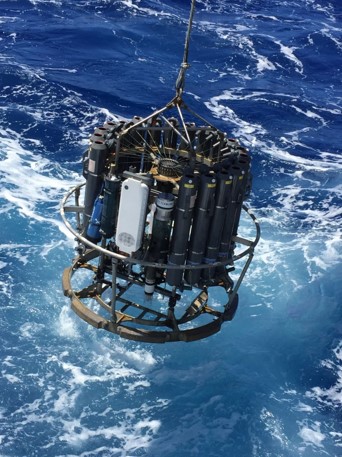Piloting Bio-GO-SHIP on US cruises: Towards a global analysis of large-scale changes to ocean plankton systems
PI/Co-PI(s): Adam Martiny (UCI), Harriet Alexander (WHOI), Sophie Clayton (ODU), Jason Graff (OSU), Nicole Poulton (Bigelow), Luke Thomson (NGI/MSU & NOAA AOML) and Paul DiGiacomo (NOAA/NESDIS/STAR)
Start Year: 2021 | Duration: 2 years
Partners: NOAA GOMO, NOAA IOOS, NOAA/NESDIS/STAR, NOAA AOML, NASA OBB, NSF Physical Oceanography Program, NSF Chemical Oceanography Program, Ocean Carbon and Biogeochemistry Program, Northern Gulf Institute/Mississippi State University, UC Irvine, Oregon State University, WHOI, Bigelow, Old Dominion University

This two-year project is part of a larger multi-agency effort and will leverage the global-reaching NOAA- and NSF-led U.S. Global Ocean Ship-based Hydrographic Investigations Program (GO-SHIP) platforms to investigate the distributions and biogeochemical roles of plankton in the global ocean. The availability of mature technologies to measure key biological variables (Boss et al., 2020), combined with the potential to leverage the GO-SHIP operational platform and its large suite of complementary physical and biogeochemical measurements (e.g., temperature, salinity, O2, nutrients, tracers, organic and inorganic carbon) offer for the first time ever the opportunity for a truly integrated global repeat sampling program.
Over the next two years, researchers will incorporate biological measurements on three U.S. GO-SHIP hydrographic cruises in the Atlantic, Pacific and Indian Oceans using established methodologies, novel techniques, and cross-disciplinary ocean observations as recommended by SCOR WG154 (Boss et al., 2020). This research team includes NOAA/OAR/AOML, NOAA/NESDIS/STAR, University of Maine, University of California at Irvine, Oregon State University, Old Dominion University, Mississippi State University, Bigelow Laboratory for Ocean Sciences, and the Woods Hole Oceanographic Institution. Specifically, this project will quantify the molecular diversity, size spectrum, chemical composition, and abundances of plankton communities across large spatial, vertical, and eventually temporal scales through systematic, high quality, and calibrated sampling of genomics, transcriptomics, plankton imaging and cytometry, pigments (in situ and also used for calibration/validation of ocean color satellite sensors), particle chemistry, and optical techniques as operational oceanographic tools.
Project URL: https://biogoship.org/

